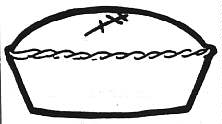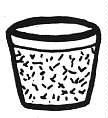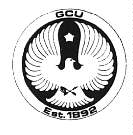
How to Put Together a Traditional Easter Basket
This reprint courtesy of the Greek Catholic Union
and first appeared in GCU Messenger, page 12 April 5, 1979
copyright 1979-1998 GCU - All Rights Reserved. Unauthorized use or distribution is prohibited

Text by: Rev. Basil Kraynyak
All Illustrations by: Mary Ellen Petro
 PASKA - The Easter
Bread (pron, paska). PASKA - The Easter
Bread (pron, paska).
A sweet , yeast bread rich in eggs, butter, etc. Symbolic of Christ Himself who is our True Bread. Usually a round loaf baked with a golden crust decorated with a symbol indicative of Christ. Sometimes a cross of dough is placed on top encircled by a plait giving it a crowned effect, or Greek abbreviations for the name of Christ. The letters XB indicate the Slavonic for "Christ is Risen." |
 CHEESE (Hrudka or
Sirets, pronounced - hrood-ka or si-rets) A custard-type cheese shaped
into a ball having a rather bland but sweet taste indicative of the moderation
that Christians should have in all things. Also, creamed cheese is placed
in a small dish and both are decorated with symbols made of cloves or pepper
balls. CHEESE (Hrudka or
Sirets, pronounced - hrood-ka or si-rets) A custard-type cheese shaped
into a ball having a rather bland but sweet taste indicative of the moderation
that Christians should have in all things. Also, creamed cheese is placed
in a small dish and both are decorated with symbols made of cloves or pepper
balls. |
 HAM (Sunka - pronounced
shoon-ka) The flesh meat popular with Slavs as the main dish because of
its richness and symbolic of the great joy and abundance of Easter. Some
may prefer lamb or veal. This is usually well roasted or cooked as well
as other meats prepared in advance so that the festivity of the day will
not be burdened with preparation and all may enjoy the Feast. HAM (Sunka - pronounced
shoon-ka) The flesh meat popular with Slavs as the main dish because of
its richness and symbolic of the great joy and abundance of Easter. Some
may prefer lamb or veal. This is usually well roasted or cooked as well
as other meats prepared in advance so that the festivity of the day will
not be burdened with preparation and all may enjoy the Feast. |
 BUTTER (Maslo - pronounced
ma-slo) This favorite dairy product is shaped into the figure of a lamb
or small cross and decorated as the cheese. This reminds us of the goodness
of Christ that we should have toward all things. BUTTER (Maslo - pronounced
ma-slo) This favorite dairy product is shaped into the figure of a lamb
or small cross and decorated as the cheese. This reminds us of the goodness
of Christ that we should have toward all things. |
 SAUSAGE (Kolbasi
- pronounced kol-bus-i) A spicy, garlicy sausage of pork products, indicative
of God's favor and generosity SAUSAGE (Kolbasi
- pronounced kol-bus-i) A spicy, garlicy sausage of pork products, indicative
of God's favor and generosity |
 BACON (Slanina - pronounced
- sla-ni-na) A piece of uncooked bacon cured with spices. Symbolic of the
overabundance of God's mercy to us. BACON (Slanina - pronounced
- sla-ni-na) A piece of uncooked bacon cured with spices. Symbolic of the
overabundance of God's mercy to us. |
 EGGS (Pisanki - pronounced
- pi-sun-ki) Hard boiled eggs brightly decorated with symbols and markings
made with beeswax. Indicative of new life and resurrection. EGGS (Pisanki - pronounced
- pi-sun-ki) Hard boiled eggs brightly decorated with symbols and markings
made with beeswax. Indicative of new life and resurrection. |
 SALT (Sol - pronounced
sol') A condiment necessary for flavor reminding the Christian of his duty
to others. SALT (Sol - pronounced
sol') A condiment necessary for flavor reminding the Christian of his duty
to others. |
 HORSERADISH (Chrin
- pronounced - khrin) Horseradish mixed with grated red beets. Symbolic
of the Passion of Christ still in our minds but sweetened with some sugar
because of the Resurrection. A bitter -sweet red colored mixture reminds
us of the sufferings of Christ. HORSERADISH (Chrin
- pronounced - khrin) Horseradish mixed with grated red beets. Symbolic
of the Passion of Christ still in our minds but sweetened with some sugar
because of the Resurrection. A bitter -sweet red colored mixture reminds
us of the sufferings of Christ. |
 These articles are placed
in a wicker basket and a ribbon or bow is tied to the handle. A decorated
candle is placed in the basket and is lit at the time of blessing. A linen
cover usually embroidered with a picture of the Risen Christ or symbol
with the words "Christ is Risen" is placed over the foods when
brought to the church. In some places a large Easter Bread (Paska) is made
and brought separately in a large linen cloth. If the origin of the people
was from a wine growing region, a sweet wine may be brought. These articles are placed
in a wicker basket and a ribbon or bow is tied to the handle. A decorated
candle is placed in the basket and is lit at the time of blessing. A linen
cover usually embroidered with a picture of the Risen Christ or symbol
with the words "Christ is Risen" is placed over the foods when
brought to the church. In some places a large Easter Bread (Paska) is made
and brought separately in a large linen cloth. If the origin of the people
was from a wine growing region, a sweet wine may be brought. |
May You Have a Happy and Blessed Easter
Christ is Risen! Christos Voskrese!
Indeed, He is Risen! Voistinu Voskrese!

Carpatho-Rusyn Easter Food Recipes